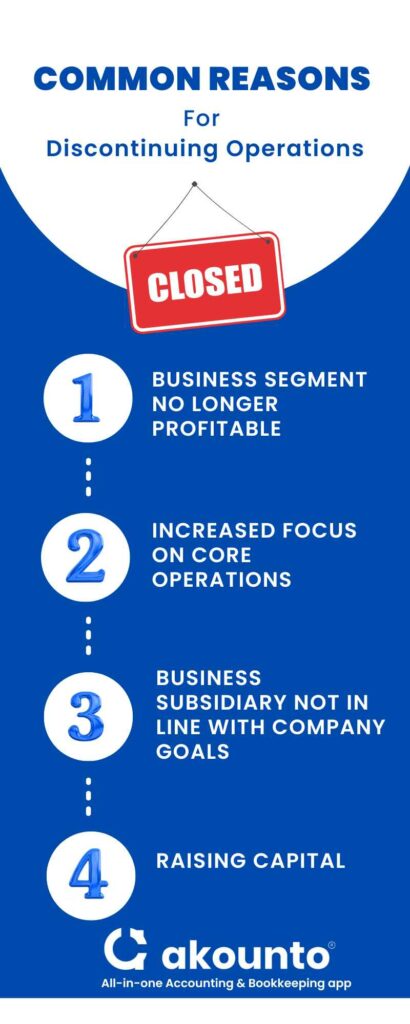Discontinued operations are specific product lines or parts of a business that have been terminated and are no longer in use.
When a company conducts a partial or complete sale of a business segment, it is classified as discontinued operations.
Such business lines should be listed separately on the financial statements. It ensures external reviewers do not confuse the company’s profitability due to misinterpretation.
What are Discontinued Operations?

Discontinued operations refer to discontinuing product lines deemed obsolete or no longer profitable in an accounting period. The disposition of equipment has reached the end of its useful life, the sale of various market segments, and changes in business models.
Once divested, the continuing involvement is stopped, and the discontinued business division or company asset is sold off.
Discontinued operations can be calculated by taking the operations and cash flows of a shut-down segment of the business and subtracting them from the company’s overall financial results in the near future.
It includes current period revenues, foreign currency costs, profits or losses, and expenses related to the discontinued operations.
The calculation should also include any gains or losses from the sale or disposal of a discontinued asset or business component.
The financial results of the discontinued operations section are reported separately from the company’s ongoing operations to provide investors with a clear picture of the company’s financial performance.
Common Examples
- Closure of a manufacturing facility: A company may close a manufacturing facility that is no longer efficient or profitable. The closure would be reported as a disposition of the component on the profit and loss statement.
- Discontinuation of a product line: A company may discontinue a product line that is no longer selling well or is not aligned with the disposal transaction. The income statement would report the discontinuation as a benefit plan obligation.
Impact of Discontinued Operations on Income Statement
The net income or loss from the discontinued operations is entered in the income statement as a separate line item, typically labeled as “Discontinued Operations.”
The company should also provide a detailed description of the nature of the discontinued operations, the date of disposal, and the gain or loss from the disposal of assets in the notes to the financial statements.
Discontinued operations are typically unprofitable. Disposing of a no longer operational segment may result in a tax benefit.
It’s crucial to remember that when including discontinued operations in an income statement, it should be done as per the International Financial Reporting Standards (IFRS) or the Generally Accepted Accounting Principles (GAAP) to guarantee the figures are accurate and comparable.

Common Reasons for Discontinued Operations
There can be many reasons a company may choose to discontinue a business segment or subsidiary. Some common reasons include the following:
- The business segment or subsidiary is no longer profitable or is expected to become unprofitable in the future.
- Divesting non-core assets to focus on core operations.
- The business segment or subsidiary is not aligned with the company’s overall strategic goals.
- The company is looking to raise capital by selling a business segment or subsidiary.
Are Discontinued Operations Taxed?
Discontinued operations may be taxed, depending on the specific circumstances of the operation and the laws and regulations in the company’s jurisdiction.
If the discontinued operation resulted in a gain, the company might be subject to taxes on that gain and its accounting purposes. If the discontinued operation resulted in a loss, the company might be able to claim a tax deduction for that loss as contingent liabilities.
The tax implications of discontinued operations can be complex. They may depend on factors such as the cash flows in the company’s overall tax situation, the specific laws and regulations in the jurisdiction where the company operates, and the circumstances of the discontinued operation.
It’s advisable to consult a tax professional to understand the tax implications of discontinued operations in your specific case.
Compliance Issues
GAAP Rules
Under Generally Accepted Accounting Principles, discontinued operation refers to certain criteria to be reported separately in financial statements. The two criteria include the following:
- The transaction used to close down the divested business will eliminate operations and cash flow no longer operational section from the other company operations.
- The discontinued operation must have minimal continuing operations involved with the parent company.
A significant difference between GAAP and IFRS is that equity method investments cannot be classified as being held for sale under GAAP in the company’s income statement.
IFRS Rules
Under IFRS, discontinued operations refer to meeting certain criteria to be reported separately in financial statements.
The criteria include the following:
- The asset or business component must already be reported or disposed of as being held for sale agreement.
- The component has to be identifiable as a separate business removed from the operation intentionally or a subsidiary of a component that is being held with the intent of disposal soon.
Net Income from Discontinued Operations
The net income or loss from discontinued operations can significantly impact a company’s overall financial performance in current and prior periods and should be carefully evaluated by investors and analysts.
Join the Akounto community and stay up-to-date on the latest accounting and financial trends. Sign up for our blog today!




